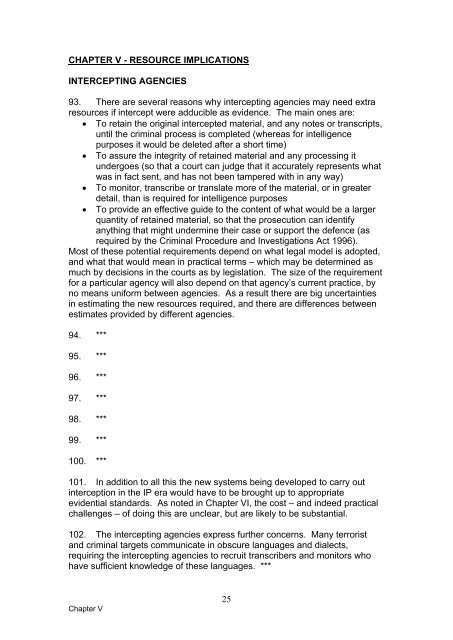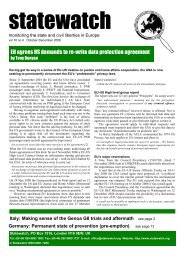Privy Council Review of intercept as evidence: report - Official ...
Privy Council Review of intercept as evidence: report - Official ...
Privy Council Review of intercept as evidence: report - Official ...
Create successful ePaper yourself
Turn your PDF publications into a flip-book with our unique Google optimized e-Paper software.
CHAPTER V - RESOURCE IMPLICATIONS<br />
INTERCEPTING AGENCIES<br />
93. There are several re<strong>as</strong>ons why <strong>intercept</strong>ing agencies may need extra<br />
resources if <strong>intercept</strong> were adducible <strong>as</strong> <strong>evidence</strong>. The main ones are:<br />
To retain the original <strong>intercept</strong>ed material, and any notes or transcripts,<br />
until the criminal process is completed (where<strong>as</strong> for intelligence<br />
purposes it would be deleted after a short time)<br />
To <strong>as</strong>sure the integrity <strong>of</strong> retained material and any processing it<br />
undergoes (so that a court can judge that it accurately represents what<br />
w<strong>as</strong> in fact sent, and h<strong>as</strong> not been tampered with in any way)<br />
To monitor, transcribe or translate more <strong>of</strong> the material, or in greater<br />
detail, than is required for intelligence purposes<br />
To provide an effective guide to the content <strong>of</strong> what would be a larger<br />
quantity <strong>of</strong> retained material, so that the prosecution can identify<br />
anything that might undermine their c<strong>as</strong>e or support the defence (<strong>as</strong><br />
required by the Criminal Procedure and Investigations Act 1996).<br />
Most <strong>of</strong> these potential requirements depend on what legal model is adopted,<br />
and what that would mean in practical terms – which may be determined <strong>as</strong><br />
much by decisions in the courts <strong>as</strong> by legislation. The size <strong>of</strong> the requirement<br />
for a particular agency will also depend on that agency’s current practice, by<br />
no means uniform between agencies. As a result there are big uncertainties<br />
in estimating the new resources required, and there are differences between<br />
estimates provided by different agencies.<br />
94. ***<br />
95. ***<br />
96. ***<br />
97. ***<br />
98. ***<br />
99. ***<br />
100. ***<br />
101. In addition to all this the new systems being developed to carry out<br />
<strong>intercept</strong>ion in the IP era would have to be brought up to appropriate<br />
evidential standards. As noted in Chapter VI, the cost – and indeed practical<br />
challenges – <strong>of</strong> doing this are unclear, but are likely to be substantial.<br />
102. The <strong>intercept</strong>ing agencies express further concerns. Many terrorist<br />
and criminal targets communicate in obscure languages and dialects,<br />
requiring the <strong>intercept</strong>ing agencies to recruit transcribers and monitors who<br />
have sufficient knowledge <strong>of</strong> these languages. ***<br />
Chapter V<br />
25
















